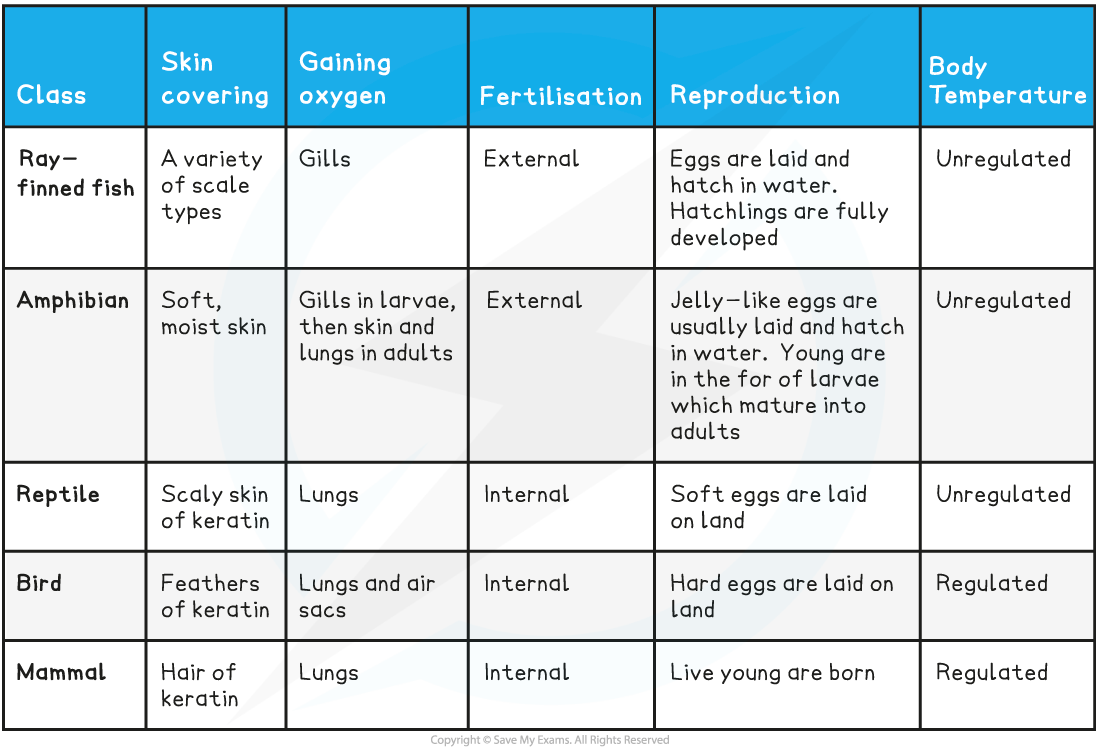Animal Phyla Features
- Animals are multicellular, eukaryotic organisms
- They are heterotrophs and most have a nervous system that enables responses to the surrounding environment
- There are over 30 animal phyla, some of which are vertebrates and some of which are invertebrates
- Vertebrates have a backbone, or spinal column, while invertebrates do not
- Some of the major animal phyla include:
- Porifera
- Cnidaria
- Platyhelminthes
- Annelida
- Mollusca
- Arthropoda
- Chordata
Porifera
- Simple aquatic organisms consisting of a colony of cells
- Commonly known as the sponges
- Once thought to be plants
- Two layers of cells surround an internal cavity
- They do not have a mouth for taking in food, or an anus for egestion
- Water is drawn in through pores in the outer layer of cells, before suspended particles from the water are filtered out and taken up by surrounding cells for food
- Porifera are filter feeders
- There is no symmetry in the body plan of the porifera
- The structure of poriferans is supported by calcium or silica formations known as spicules

Porifera take in water through pores for filter feeding
Cnidaria
- Aquatic organisms also known as the coelenterates
- Their body cavity is surrounded by two layers of cells and has a single opening for both ingestion and egestion
- There are two distinct body forms present in the cnidaria phylum
- Polyps, or hydroids are sessile e.g. coral and anemones
- Medusae (singular medusa) float in the water e.g. jellyfish
- Some cnidaria go through both the polyp and medusa body form during their life cycle
- Polyps are filter feeders, while medusae catch prey using stinging cells on their tentacles
- There is radial symmetry in the body plan of the cnidaria
- Most cnidaria have soft bodies that rely on the surrounding water for support, but corals secrete an exoskeleton made of calcium carbonate
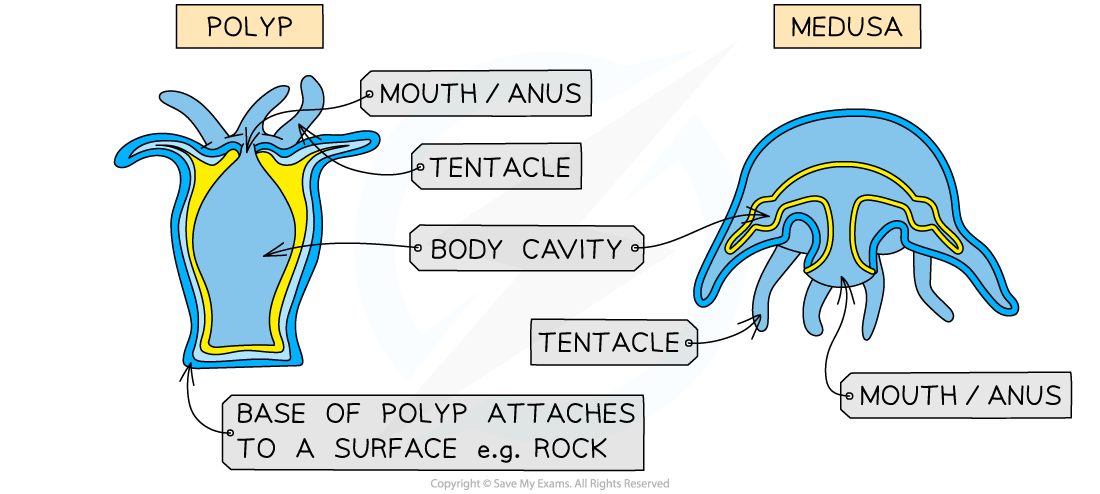
Cnidaria have two distinct body forms; polyps and medusae
Platyhelminthes
- Flat-bodied, unsegmented worms that include the flatworms, tapeworms, and flukes
- Three layers of cells surround a branched gut with one opening for both ingestion and egestion
- Platyhelminthes can be free-living predators or scavengers, or parasites that feed on their hosts
- The flat body shape of platyhelminthes means that the diffusion distance to all cells is short, and no circulatory system is present
- There is bilateral symmetry in the body plan of the platyhelminthes
- Platyhelminthes have soft bodies with no skeletal support
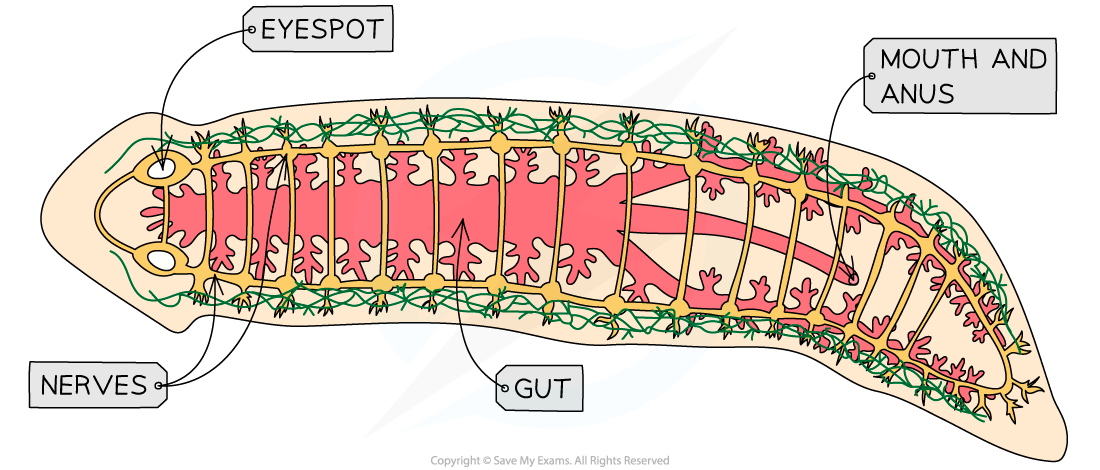
The body structure of a member of the phylum Platyhelminthes
Annelida
- Round-bodied, segmented worms that include the earthworms and the leeches
- Each ring-shaped body segment contains a repetition of the structures of blood vessels and nerves
- The gut has separate openings for the mouth and anus
- Annelida can be free-living predators or scavengers, or parasites that feed on their hosts
- Annelida have a closed circulatory system
- There is bilateral symmetry in the body plan of the annelida
- Annelida have soft bodies which are supported by a hydroskeleton
- The hydroskeleton is an internal fluid-filled cavity called the coelom, against which the muscles of the body wall exert pressure
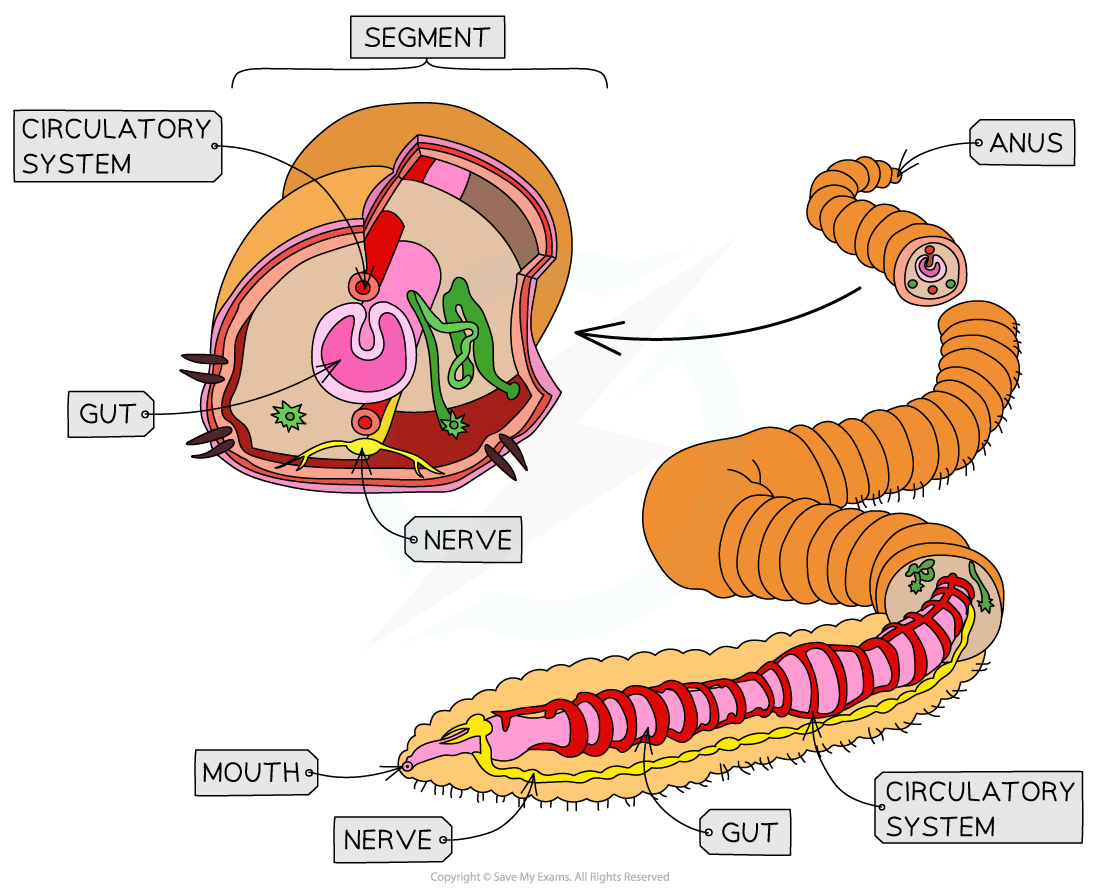
The annelida have a segmented body structure
Mollusca
- A diverse group of animals that includes the snails, slugs, mussels, limpets, and octopuses
- It is the second-largest phylum (i.e. it contains a higher number of recorded species than any other phylum, except for Arthropoda)
- Most molluscs are aquatic, with some terrestrial species
- The body structure contains a muscular foot and a visceral mass
- The foot is used for motion and/or anchorage e.g. as in limpets
- The visceral mass is located above the foot and contains the internal organs (i.e. it is the soft, metabolic region that contains the digestive, excretory and reproductive organs)
- The gut has separate openings for the mouth and anus
- Mollusca have several feeding methods, including:
- Filter feeding e.g. in bivalves such as mussels
- Scraping at food sources such as leaves or algae on rocks using a rough, tongue-like organ called a radula e.g. snails and limpets
- Active predation e.g. sea slugs
- Most mollusca have an open circulatory system in which the transport fluid bathes the internal organs
- The cephalopods, which include squid and octopuses have a closed circulatory system
- There is bilateral symmetry in the body plan of the mollusca
- Mollusca have soft bodies that sometimes secrete a calcium carbonate shell from a mantle e.g. snails

The body structure of snails; members of phylum Mollusca
Arthropoda
- Animals with segmented bodies, a hard exoskeleton, and jointed limbs
- It is the largest phylum (i.e. it contains a higher number of recorded species than any other phylum)
- It includes insects, arachnids, crustaceans, centipedes, and millipedes
- There is usually one pair of jointed limbs per body segment, though this is not always the case
- The gut has separate openings for the mouth and anus
- Arthropoda have an open circulatory system
- There is bilateral symmetry in the body plan of the arthropoda
- Arthropoda have a hard exoskeleton made of chitin
- The exoskeleton is shed as the animal grows
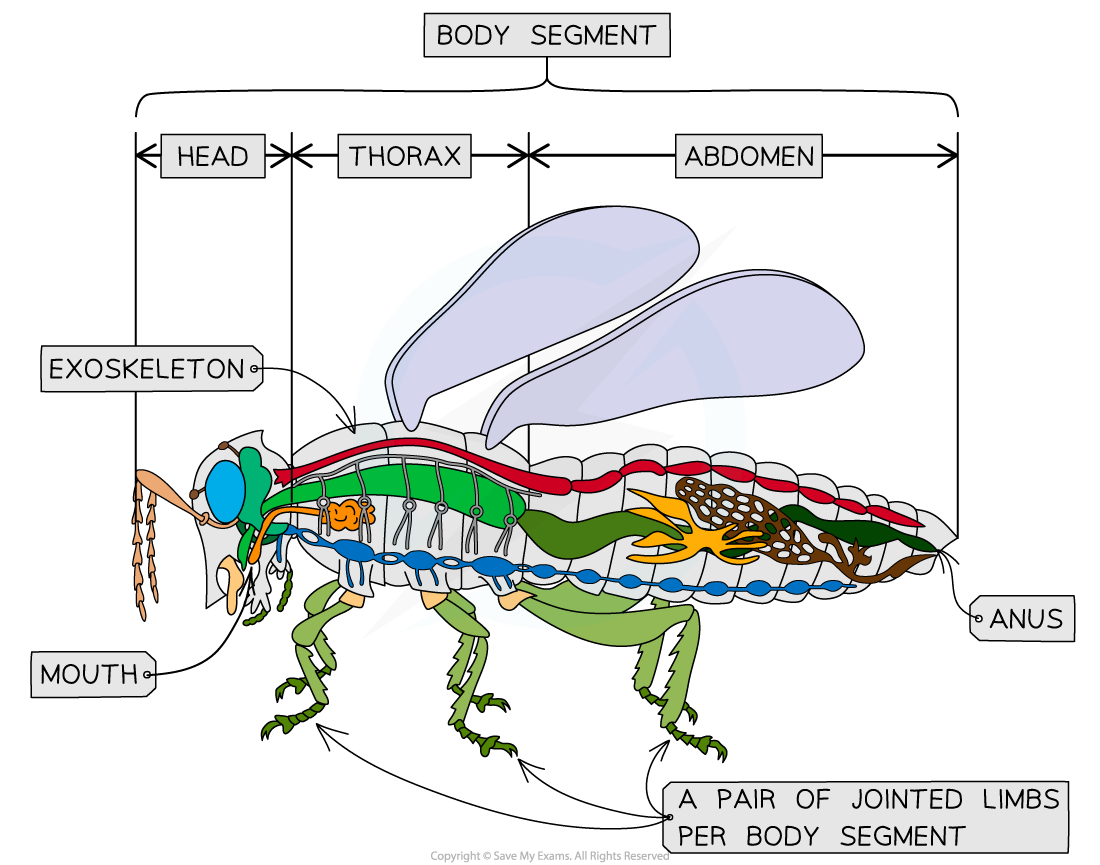
Insects are members of the phylum Arthropoda; they have three body segments, each with a pair of jointed limbs
Chordata
- The phylum chordata includes all of the vertebrates, as well as some invertebrates such as the tunicates; commonly known as sea squirts
- To be classified as a chordate, an organism must have the following features at some stage during its development:
- A rod-like structure along the dorsal length of the body known as a notochord
- Dorsal refers to the back of an organism
- A hollow nerve cord located in the dorsal region
- A series of slits behind the mouth known as pharyngeal slits
- A tail that extends beyond the anus, known as a post-anal tail
- A rod-like structure along the dorsal length of the body known as a notochord
- Some chordates only have these features during the embryonic stages of development, e.g.
- In vertebrates, the notochord is replaced with the spinal column in fully developed individuals
- The dorsal hollow nerve cord develops into the brain and spinal cord in most species of chordate
- The pharyngeal slits are only retained into adulthood in some types of chordate e.g. in the gills of fish
- The post-anal tail has become a vestigial structure in the great apes
- Vestigial structures are those that have lost their function, and are sometimes known as 'evolutionary leftovers'
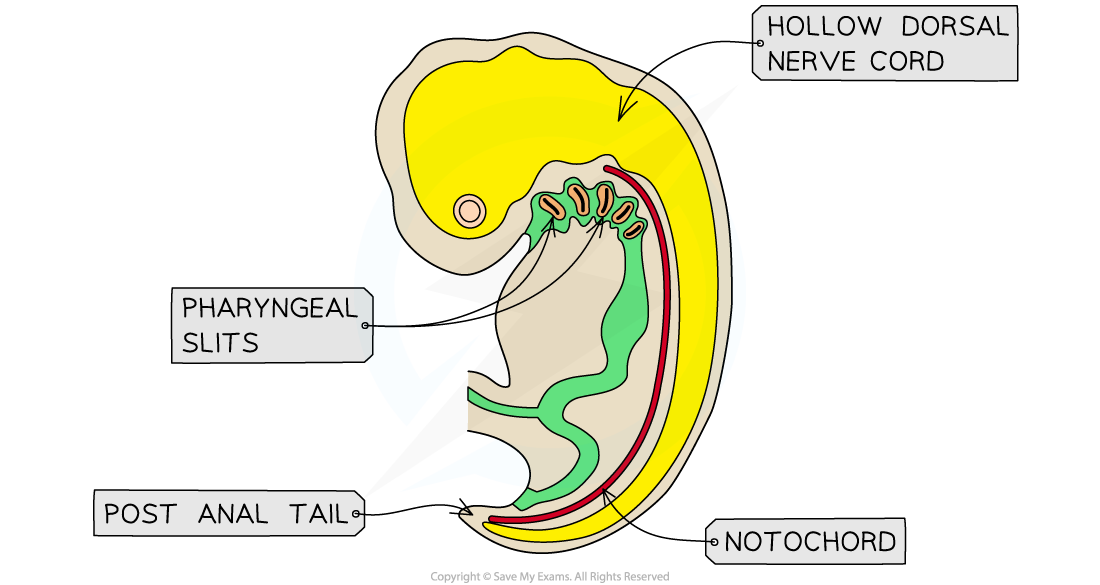
Human embryos have all of the features of phylum chordata
Phyla Features Table
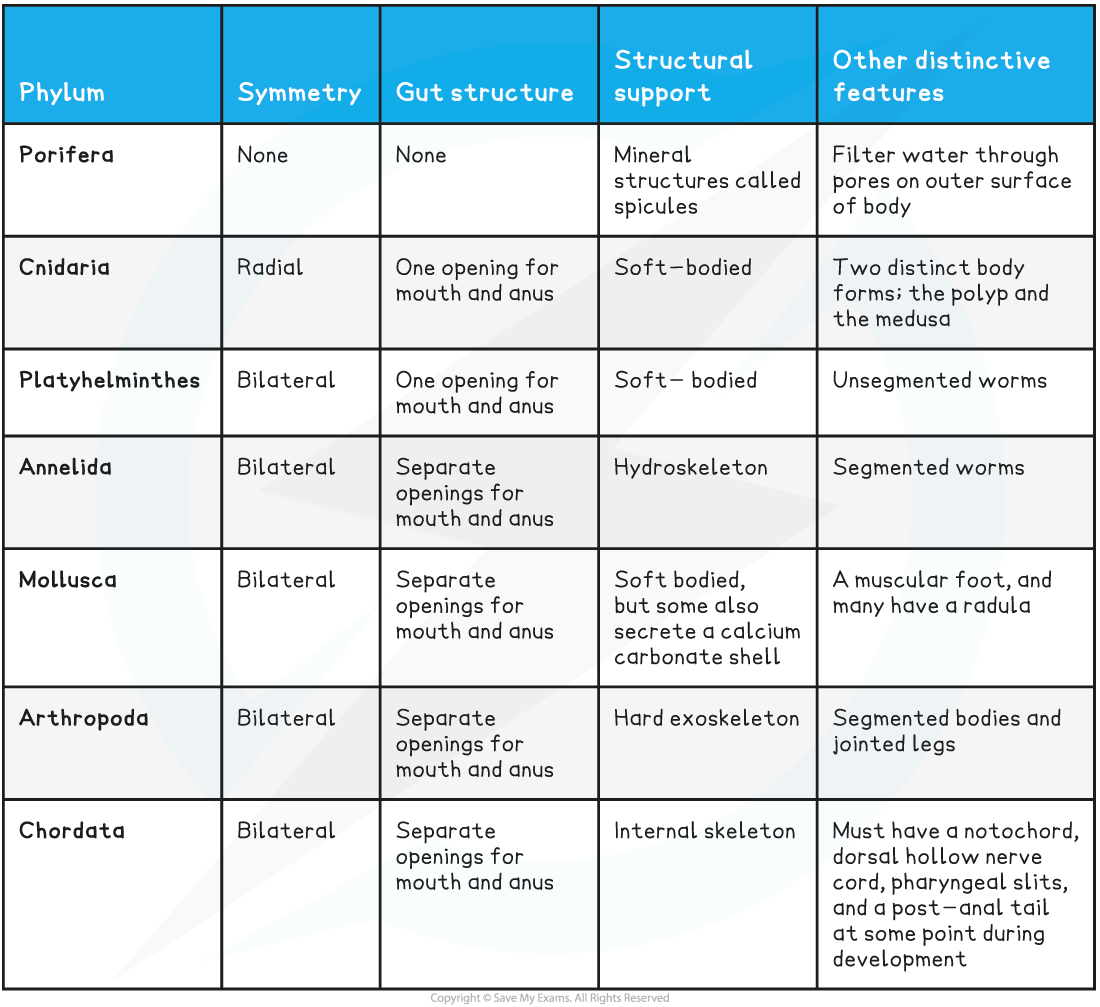
Exam Tip
You do not need to be able to describe each of the above phyla in great detail, but be sure that you can state how each phylum is distinct from the other phyla, e.g. annelids are segmented worms while platyhelminthes are unsegmented worms, mollusca is the only phylum with a muscular foot, etc.
Vertebrate Features
- The vertebrates are organisms that have a spinal column made up of vertebrae
- There are 5 major classes of vertebrate
- Bony ray-finned fish (27 000 species)
- There are other classes of fish, e.g. the bony lobe-finned fish (6 species), and the cartilaginous fish, whose skeletons are made of cartilage rather than bone (around 900 species)
- Bony ray-finned fish (27 000 species)
- Amphibians (6000 species)
- Reptiles (9000 species)
- Birds (10 000 species)
- Mammals (5 700 species)
Bony ray-finned fish
- The ray-finned fish, also known as class Actinopterygii, have skeletons made of bone, and fins supported by rays, or spines, of bone
- The scales covering the bodies of the ray-finned fish vary in shape and composition
- Oxygen is gained via diffusion from the water into the gills, which are covered by a gill flap called the operculum
- During reproduction, eggs and sperm are released into the water and fertilisation takes place outside the body; this is external fertilisation
- Their entire life cycle is aquatic
- Body temperature is not regulated but changes with the surrounding environmental temperatures
- Buoyancy is regulated by inflating and deflating an internal air sac called a swim bladder
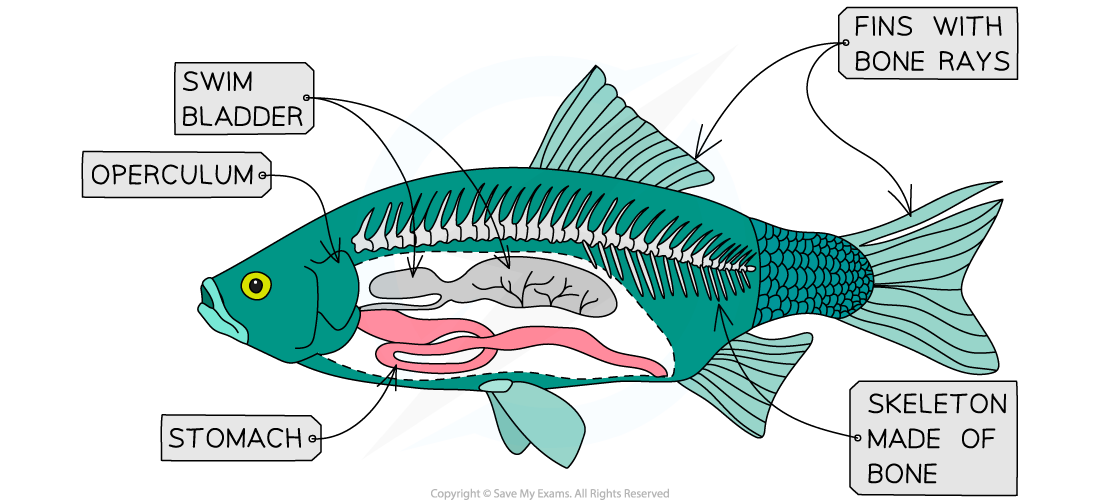
Ray-finned fish have a skeleton of bone, fins with bone rays, a swim bladder, and a gill operculum
Amphibians
- This class includes animals such as frogs, toads, and salamanders
- Amphibians have soft, moist skin
- Amphibian skin is permeable, enabling exchange of gases while under the water
- Simple lungs are also present for gas exchange on land
- During reproduction, fertilisation is external
- Jelly-like eggs must be laid in water, and the larval stage of the life-cycle is aquatic e.g. frog tadpoles
- Larvae such as tadpoles mature into an adult body form
- Adult amphibians often leave the water and spend most of their time on land
- There are a few exceptions to this; some frog and toad species can lay eggs on land which hatch into tiny adults rather than tadpoles
- Body temperature is not regulated
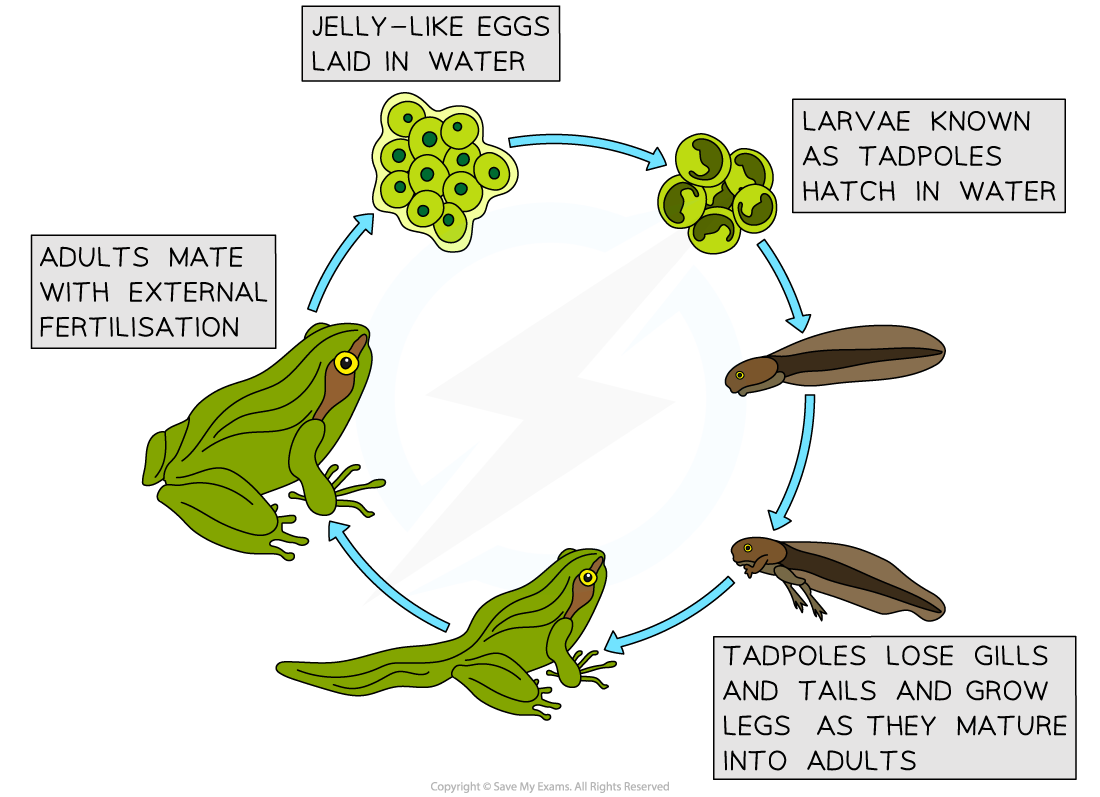
The amphibian life-cycle includes an aquatic larval stage, and a terrestrial adult stage
Reptiles
- This class includes animals such as lizards, snakes, and turtles
- Reptiles have impermeable, scaly skin made of keratin protein
- Reptiles are mainly terrestrial, gaining their oxygen through highly folded surfaces in their lungs
- During reproduction, male sperm is deposited inside the female's body, so fertilisation is internal
- The eggs of reptiles are soft-shelled
- Reptile body temperature is not regulated
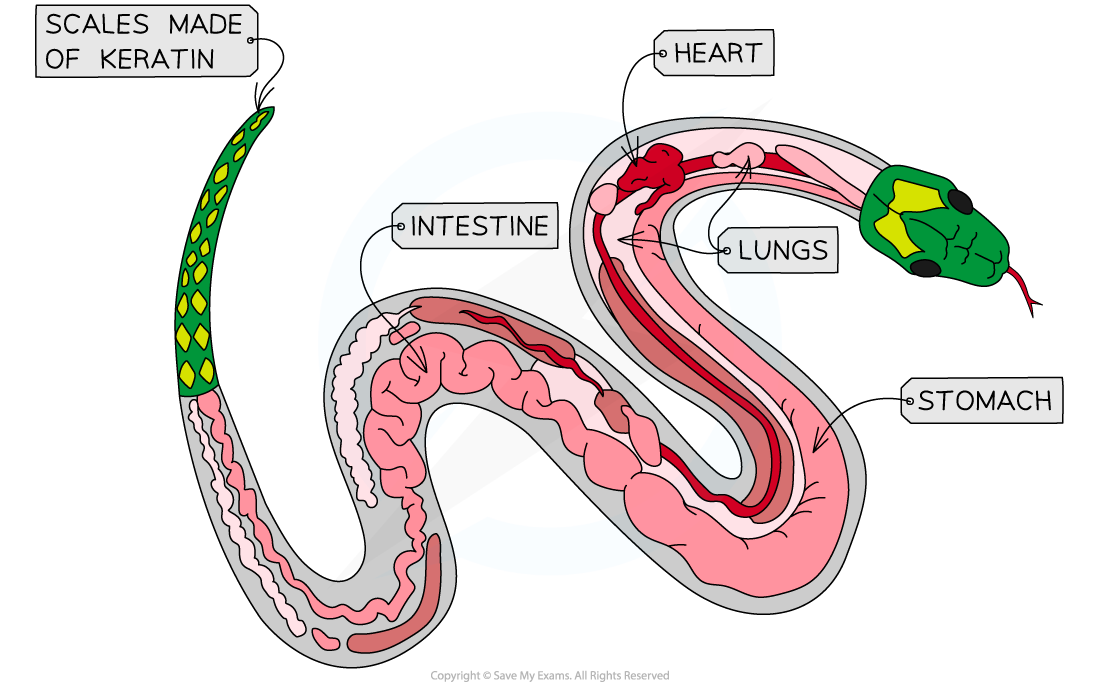
Reptiles have a body covering of scales, and breathe using highly folded lungs
Birds
- This class includes animals such as chickens and ostriches
- Skin is covered with feathers made of keratin
- The front limbs of birds are modified into wings, and skeletons are lightweight, both adaptations for flight
- Birds gain oxygen via a pair of lungs and connected air sacs
- Fertilisation is internal
- The eggs of birds are hard-shelled
- Shells contain calcium carbonate
- Bird body temperature is regulated, so is often warmer than the surrounding environment
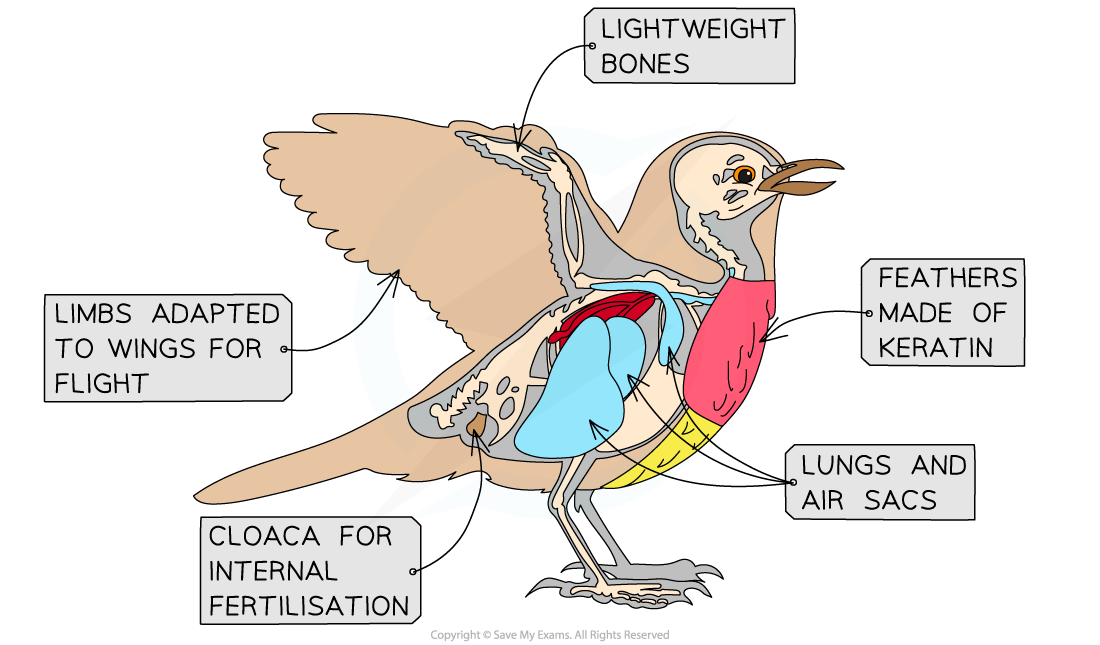
Birds are usually highly adapted for flight and reproduce using internal fertilisation
Mammals
- This class includes animals such as elephants, humans, and whales
- Skin is covered with hair made of keratin
- In some mammals body hair is lost in adulthood, e.g. in aquatic mammals
- Mammals gain oxygen via a pair of lungs
- Fertilisation is internal
- The young of mammals develops inside the body of the mother, and live young are born
- There are some unusual exceptions to this e.g. the duck-billed platypus and the echidna
- Young mammals are fed on milk produced in mammary glands
- Mammal body temperature is regulated
Vertebrate Features Table
